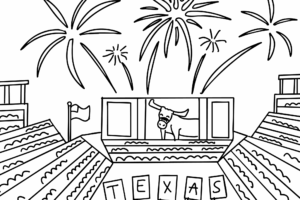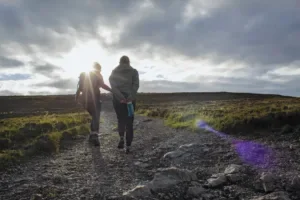Time. Place. Inspiration. Trust. A feeling of home – some reflections of the more than 40 former fellows who returned to the Paisano ranch on March 8 to celebrate the 40th anniversary of the Dobie Paisano Fellowship Program. They came to remember their time at this special place, to meet the only other people in the world who could understand what the ranch means to them, and to honor the fellowship program that transformed their lives.
Founded in 1967 to honor Texas folklorist and writer J. Frank Dobie, the ranch and writer-in-residence fellowship program provides solitude, time, and a comfortable place for Texas writers or writers who have written significantly about Texas. To date, 79 fellows have occupied the rustic little house and reaped the benefits of this hill country retreat.
As the buses rolled in to deliver the guests to the ranch for the anniversary celebration, the glorious sunlight barely outshone the excitement and anticipation of the returning fellows and honored guests. Soon screenwriters, playwrights, poets, novelists, animators, potters, photographers, weavers and artists were getting to know one another and sharing their experiences as Dobie Paisano fellows. And all spent time before one of the many displays set up in and around the old Dobie housedisplays that showcased the many accomplishments of the former fellows: more than 100 books of poetry, fiction, and non-fiction, numerous feature films, documentaries for PBS, highly rated television episodes and miniseries, important theatre productions, and countless state and national literary awards.
Sarah Glasscock, 1992 fellow, novelist and writer of educational books for children (on topics ranging from immigration to women who’ve shaped American culture) spoke for many when she shared what the Paisano fellowship meant to her: “I think the words inspiration and trust most sum up my stay at Paisano. Inspiration comes from the beauty of the land and the sweet ranch house and from being one link in a long chain of fellows. Trust comes from the fact that the university entrusted J. Frank Dobie’s house and 254 acres to me for six months. The trust worked both ways, too, because I always knew–through flood, fire, or wandering longhorns–that Audrey Slate and Clint Smith would go out of their way to take care of me.”
The program’s very first fellow, Billy Porterfield, former writer for the Houston Chronicle, and author of a poignant chronicle of his 12-year Depression-era odyssey on the road with his parents, brother and sister, was joined by the most recent fellow, Allison Moore, who is writing of another journey. Her historical fiction records the lives of children who rode the Orphan Train a one-way train out of New York City that delivered unwanted and orphaned children to train stops throughout the United States, including Texas, where they were literally inspected especially the teeth and chosen or not chosen on the spot.
One of the day’s special guests was Sr. Jose Cisneros, illustrator renowned for his historical depictions of the people and culture of the old Southwest. His BorderlandsThe Heritage of the Lower Rio Grande through the Art of Jose Cisneros chronicles events in the history of the border between Texas and Mexico. For his contribution to understanding history through his art, he was honored by Pope Paul II, the King of Spain, Juan Carlos I, and by then Governor George W. Bush.
Born in 1910, Cisneros was the oldest fellow to return to the ranch. As a child, his family lost all their belongings when their home in Durango was looted during the Mexican Revolution. After many difficult years of wandering, the family settled in Juarez, Mexico. When Cisneros arrived in El Paso, Texas at fifteen years of age, he had only had four years of schooling, all of which had to be repeated. Fond of books and Spanish American History, he used the horsemen as his main subjects. And since he is color-blind, he worked in pen-and-ink and with a box of colored pencils marked so he could read their colors.
After receiving a moving tribute, Sr. Cisneros spoke briefly of his pleasure in returning to the ranch and what his experience there meant to him. Having spent his career creating art that was commissioned by others, his fellowship in 1969 afforded him the time, place, and financial support to create the art that he wanted to create. He said that in becoming a Paisano fellow, he found the freedom to paint what he wanted to paint, and thus was born the true artist inside him.
To read more about the 40th anniversary, please visit http://www.utexas.edu/ogs/about/features/paisano.html.



